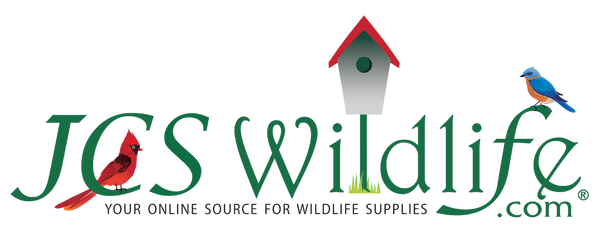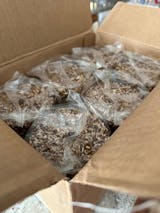
February is National Bird Feeding Month in the US. And with winter being the hardest time for birds to find food, what better time to fill up the feeders and start attracting birds to your yard? However, how do you know which is the best feeder? Which seed is best? Where should you put the feeder and how do you ensure it is working most efficiently for you? And is it even possible to attract birds to your yard this time of year? We get these questions quite a bit, so read on for the answers to all of these and more!
Which style of feeder is the best for you? You have several options, but please keep in mind that the food you put in the feeder is just as important as the style of feeder.
The window feeder: Imagine looking up from your morning cereal to see a Cardinal perched outside your window! Window birdfeeders are among the easiest to fill and maintain, and they attract the largest variety of birds. Mount these to any window or glass door to which you have easy access (make sure the outside of the window is clean and dry when you are ready to mount. Windows that can be reached comfortably from the ground or patio are the best options. Tilt Out or Tilt and Turn windows can also make the task of filling and maintaining your feeder easier. Window feeders are generally platform-style feeders, which also may attract larger nuisance birds and squirrels. Look for feeders with roofs or cages to help keep pests away.
The hopper feeder: Watching birds at a hopper-style feeder evokes a sense of community. Birds will bunch up and "talk" over their food or just perch and watch the world around them. Most hopper feeders offer a central reservoir or silo to hold the seed and a platform-style perch where the visitors may sit and eat. For winter feeding look for a feeder with a large enough roof to shield the birds from rain and snow. Like the window feeder, this style attracts several varieties of birds. And, like the window feeder, they can attract foragers and squirrels.
The tube feeder: What if you already know the type of birds you want to attract, and they don't include large "bully" birds? Tube-style feeders offer smaller perches that larger foragers such as blackbirds are not as comfortable using. Unfortunately, tube feeders have a notoriously bad rap as being difficult to maintain. Seed cakes together in the bottom of the tube as the temperature rises and falls, making the food impossible to eat and hard to clean out. Fear not! Current models available offer easy cleaning options. Look for models with internal baffles to keep the seed flowing, removable endcaps for easy access for you, and/or styles where the lowest perch is level with (or below) the bottom of the tube.
The squirrel-proof feeder: You want to feed the birds, not the squirrels, right? You are not alone. Squirrels will scare birds away from your yard, eat all your food, and just generally cause trouble. While it is true that we see less squirrels in some areas during the coldest months, they are still there. And the problem is that they, too, are having a harder time finding sources of fresh food. So, squirrel logic dictates that they steal what they can from the birds-- makes sense, right? Not when you are spending most of your time and money filling the birdfeeder. Squirrel-proof feeders are just that-- birdfeeders that supply food to the birds, but not the squirrels. Many available now are stylish and easy to maintain without an engineering degree. Look for models with adjustable settings and large enough that the squirrel cannot grip the perch from the top of the feeder.
Other feeder styles: There are other feeder options available depending on the food you choose to use, your specific taste, or the types of birds you hope to attract. Suet feeders may be filled with cakes of rendered beef fat (suet) that has been mixed with seeds and other natural ingredients. This is a great way to attract Woodpeckers to your yard. Metal mesh feeders come in a variety of shapes and sizes. Many work as tube or hopper feeders, but go a step further by attracting clinging birds such as Finches, Woodpeckers, and Nuthatches. Fabric mesh feeders or sacks are filled with thistle or Nyjer seed and are meant to specifically attract Finches. When looking for the types of feeders listed here, or any specialty feeder, pay close attention to the best type of seed for the feeder and look for information on which birds will use the feeder.
What food is best for birds?
If there seems to be an overwhelming number of options when it comes to feeder style, there are even more options when it comes to filling those feeders. Many manufacturers are fairly straight forward about what food is best in their feeder. Suet goes in suet feeders, thistle or Nyjer goes in thistle sacks, peanuts go in peanut wreaths, and so on. Mixed seed feeders, or feeders that do not specify which seed to use can be a little more tricky.
Seed and seed blends: Black oil sunflower is by far the most common food or ingredient for birds. This seed attracts the largest variety and is readily available. If you have a squirrel problem, you may want to substitute safflower or a safflower blend. While this isn't a guarantee to stop the squirrels, they highly prefer sunflower seeds to bitter safflower. When using a seed mix remember that ingredients such as golden millet, red millet, and flax are fillers. So make sure that if they are an ingredient that they appear lower on the list.
Suet: Suet is an excellent source of energy for cold birds. It is often blended with insects, berries, and other natural ingredients that will sustain a bird in the winter. Remember that birds sometimes have a long way to travel between meals in cold months. There is also significantly little waste involved with suet. Again, there are different types or flavors that attract different birds.
Nectars: If you are fortunate enough to have Hummingbirds and Orioles year-round (mostly in the southwest regions of the country), filling and hanging nectar feeders will keep them in your yard through generations.
Hot pepper: Capsicum, or hot pepper, has been added to suet, seed blends, and can even be found in bottles to mix in at home. This ingredient ranges from spicy to physically painful when we eat it ourselves, and squirrels, also being mammals, find it unpleasant. Birds, on the other hand, are completely unaffected by it and it is a natural deterrent to keep unwanted critters out of your feeders. Be sure to handle any bird food that has hot pepper added very carefully. Even the smallest amount of capsicum oil in the eye or a wound is not fun!
Other foods: There are several other types of food available on the market, including insects, nuts, jellies, and corn. Most food manufacturers state specifically which species for which the food is best suited. Jellies are generally used for Oriole feeders and insects for Bluebirds. However, while peanuts and tree nuts are loved by many different species, including squirrels and other rodents, corn is used as a filler and not often eaten by birds.
Where should you place your feeder?
Feeder placement is just as important as the style of feeder and the food you select to fill it. While window feeder placement is pretty self-explanatory, that may not be the case for hanging and pole-mounted feeders. According to the Cornell Lab of Ornithology, place the feeder in an open area with shrubs about 10 feet away. You may hang feeders in trees or on hooks in your yard. When hanging a squirrel-proof feeder, protect your investment by ensuring that squirrels cannot grasp the pole and steal food from the feeder without setting off the weight sensor.
According to Cornell, there is also a danger zone for birds striking windows. If you experience a problem with birds hurting themselves after hitting your window, consider moving your feeder. The danger zone is 5-10 meters. Anything closer than 5 meters, and the birds will not build enough momentum to hurt themselves.

Anything else?
Attract the greatest number of birds by keeping your feeders clean, full, and in plain view. Ensure that there is shrubbery in close proximity to feeders for shelter. Also, consider adding a heated birdbath or a deicer to your existing bath. There is no need to keep the water any warmer than just above freezing-- any higher will actually waste water and electricity. Placing sticks and rocks in the bath will also help the birds who want to perch and drink. Please note that many experts highly advise against adding soaps or glycerin (once popular deicers in birdbaths) to the water-- this can actually harm the birds by matting their feathers and preventing them from staying warm and dry.
Enjoy watching your birds this winter and stay warm!






